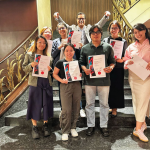The top five airline brands in the world are Asian…
Last year, Indigo Airlines, India’s top carrier, placed an order for 500 single-aisle jets with Airbus Industrie, the largest-ever order in the airline industry worldwide.
That order came hot on the heels of another order of 470 jetliners—250 from Airbus and 220 from Boeing—by Air India.
These massive orders illustrate a broader trend: the rise of Asian brands in the global marketplace.
Airline capacity in India—at 230 million departing seats in 2024—is expected to grow to 350 million by 2030 and leapfrog to a billion passengers by 2040.
The battle for passengers’ wallets is expected to be fierce between the decades-old Air India, now owned by the Tatas, and the far newer Indigo, with other players such as AirAsia, SpiceJet, and the recently launched Akasa Air jostling for market share.
Indigo’s brand value, according to Brand Finance, surged between 2023 and 2024 by 26% to USD 1.1 billion, earning it the distinction of the second-strongest airline brand in 2024.
This is not an isolated case; the strength of Asian brands extends well beyond aviation.

Does it surprise us that the top five strongest airline brands worldwide are all Asian?
Driving Growth
Indeed, the growth in the number of Asian brands in the overall ranking is much higher than that of American or European brands.
While in the last 10 years, American brands have increased by 2%, and European brands have decreased by 10%, Asia-Pacific brands have grown by more than 7%.
But what drives this growth?
A closer look reveals that it’s not just numbers; it’s about understanding cultural nuances and unique consumer behaviours.
It is also the continent that has increased the most in terms of the percentage of brand value contributed.
The contribution of brand value by APAC brands has increased from 22% in 2012 to 31% in 2022, an increase of 9%, whereas American brands increased by 4%, and European brands decreased by 14%.
Asian brands are recognising and building on the unique identities, preferences, and aspirations of local markets and communities, forging genuine connections that transcend mere transactions, fostering advocacy, and ultimately driving value for the brand.
Understanding Cultural Influence and Unique Behaviours
In consumer packaged goods, local brands in Asia represent 73.2% of FMCG spending.
They are harnessing innovative technologies and platforms to elevate their position to premium, shifting away from the old notion that being local is simply cheap or affordable.
This strategic adaptation is also evident in how local brands leverage digital platforms to expand their market reach.
Platforms like TikTok allow creators to express themselves and start trends, while brands create and leverage content at remarkable speed, targeting specific communities or interest groups.
Local and regional e-commerce channels such as Shopee, Lazada, Myntra, Meesho, and Taobao provide opportunities for local brands to punch above their weight and enjoy price advantages bolstered by their meaningful, different positions.
The success of Korean skincare brands in Southeast Asia can be attributed not only to their leverage of the Korean wave but also to their deep understanding of how consumers in each market are unique and have different needs.
Singaporeans, for example, are keen on weightless feel skincare products due to the humid environment, Malaysians want to enhance their youthful appearance, while Thais pay more attention to serums and lotions since they are prone to problems such as dry skin.
Brands such as Laneige and SK-II are able to use tech to offer specific solutions for each market and segment while creating a unified imagery through K-Beauty cues.
Across Asia, consumer preferences vary significantly, and brands that can navigate these differences are seeing substantial success.
The rise of highly engaging social media formats, the recent trend of livestream shopping, and the growing interest in e-retailer advertising have empowered Asian brands, which historically have had a disadvantage in advertising muscle on traditional platforms.
The speed of tech has helped to dispel the notion that a local brand is a cheap brand by opening up more avenues to reach modern-day consumers.
For 81% of skincare consumers in Indonesia, e-commerce is the preferred channel because of competitive pricing and the ability to consult reviews.
However, brick-and-mortar shopping remains in demand, especially for skincare, where beauty stores and pharmacies are trusted purchasing channels.
The advantage of in-store shopping revolves around the ability to sample products and consult with experts in the store.
No small wonder that the archipelago nation’s leading skincare brand, Wardah, provides personal skincare consultations through its extensive chain of clinics.
The brand also stages events such as Wardah Skinverse, where its latest Personalised RoboSkin AI technology identifies individual skin requirements, tailors skincare in real-time, and provides targeted solutions that cater to specific needs.
Competing and Winning Globally
Asian brands are finding more and better ways to distinguish themselves from their global competitors while still being relevant.
This elevates difference to more than just a distinct brand or product promise and looks into a more nuanced exploration of what it means to be different—particularly in developed markets.
Temu, an e-commerce platform, has attracted many middle-class and low-income consumers in the US.
Based on a survey of credit card data, about 18% of U.S. households have shopped with Temu since its launch just two years ago.
The total number of Temu users in the U.S. is between 150 and 160 million (globally 480 million), and it has about 80 million monthly active users, of which 50 million make monthly purchases.
The average usage time on Temu is 23 minutes—5 minutes more than Amazon, 8 minutes more than Walmart—a testimony to the app’s stickiness. Two-thirds of its users are women.
Temu’s GMV surged to US$20 Billion in first half of 2024
Temu expanded its advertising by more than 1,000% to $480 million, investing heavily in sponsored social in 2023.
It spent heavily during the Super Bowl on Sunday night (Feb 11) with its “Shop Like a Billionaire” 30-second ad airing six times. The investment is paying off.
Temu’s gross merchandise value (GMV) surged to about US$20 billion in the first half of this year, surpassing its overall sales of US$18 billion in 2023.
The brand has, at last count, expanded its footprint to sixty-five countries.
Temu, like Shopee, incorporates games as part of their shopping strategy.
Games such as Fishland, Coin Spin, and Card Flip provide prizes, encourage players to spend more time on the site, and experience the thrill of winning free things.
The e-commerce platform relies significantly on referrals, which are an important component of its revenue model, to keep players engaged in these games.
Temu’s aggressive marketing and engagement tactics have proven effective in the US, and it now aims to replicate this success in Southeast Asia.
With Southeast Asia’s e-commerce market forecast to reach US$230 billion in GMV by 2026, Temu’s entry into Malaysia last September—against dominant established players like Lazada, Shopee, and TikTok Shop—will be interesting to watch.
How do you expect the platform to differentiate itself? What brand proposition should it create and pursue? What kind of cultural codes and consumer relationships should it build?
Understanding these dynamics is crucial for anyone looking to tap into the burgeoning Asian market.
EDITOR’S NOTE: Kunal will be running a 2-day in-depth workshop on Marketing Codes of Asian Brands for marketers this November 6 & 7. Limited seats available, through advance bookings, with ruby@adoimagazine.com
Kunal Sinha is Chief Knowledge Officer at Ampersand Advisory, KL. He has built brands across China, India, and Indonesia, is the author of six books on creativity, consumers, and marketing, and has spoken at the world’s top business schools, including Harvard, Cambridge, London Business School, University of New South Wales, and CEIBS.
MARKETING Magazine is not responsible for the content of external sites.











